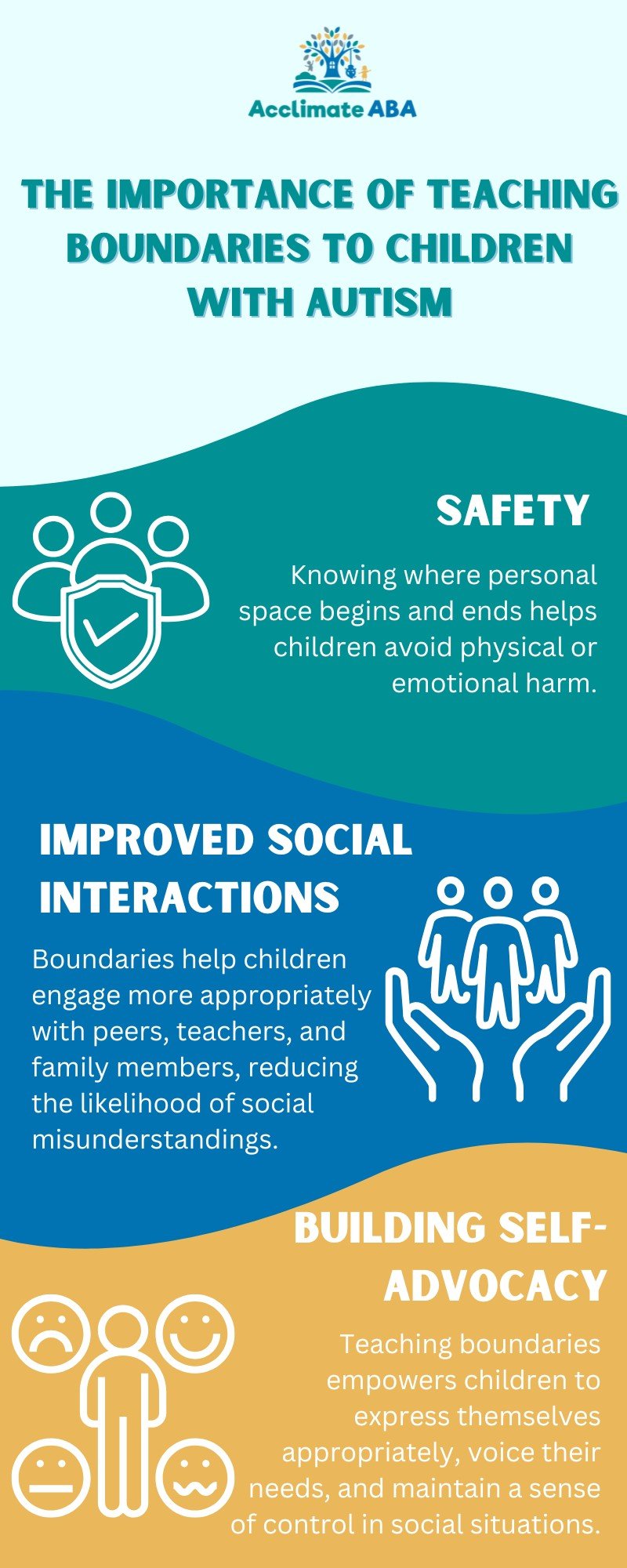Teaching Boundaries to Children with Autism

Key Points:
- Setting and teaching boundaries is crucial for children with autism to ensure their safety and well-being.
- Using ABA (Applied Behavior Analysis) strategies can help children understand personal space and acceptable behaviors.
- Clear communication, consistency, and visual aids are effective tools for teaching boundaries.
Many parents of children with autism may notice boundary-related challenges in their child’s behavior—whether it’s difficulty respecting personal space, understanding social cues, or managing emotions in social settings. These issues can lead to awkward or even unsafe situations. Teaching children with autism how to recognize and respect boundaries is essential for their safety and social development.
What Does Teaching Boundaries to Children with Autism Mean?
Teaching boundaries autism involves helping children understand personal space, what behaviors are appropriate in different settings, and how to engage in respectful social interactions. This process may take time, as children with autism often have difficulties with social cues, interpreting facial expressions, and reading non-verbal signals.
The concept of boundaries is foundational in building healthy relationships, promoting safety, and encouraging independence. Children with autism, however, may not naturally grasp these concepts. Here’s why it’s vital to focus on teaching boundaries:

How Can ABA Therapy Be Used in Teaching Boundaries?
ABA therapy is one of the most effective ways to help children with autism learn various skills, including social boundaries. Applied Behavior Analysis (ABA) uses evidence-based techniques to teach new behaviors while reducing harmful or undesirable behaviors. When it comes to teaching boundaries autism, ABA therapy incorporates the following strategies:
- Task Analysis: Breaking down complex tasks, like learning personal space or appropriate social behaviors, into smaller, manageable steps.
- Reinforcement: Positive reinforcement encourages children to repeat desired behaviors, such as respecting someone’s personal space, by rewarding them when they do so.
- Modeling: The therapist or caregiver demonstrates appropriate behavior, such as asking for permission before entering someone’s personal space, so the child can observe and replicate the action.
- Generalization: Helping children apply the boundaries they learn in therapy to real-life situations, such as at school or at a friend’s house.

Practical Techniques for Teaching Boundaries to Children with Autism
While every child is unique, there are common methods that parents and therapists can use to teach boundaries. The following strategies can help reinforce the concept of personal space and social expectations:
1. Use Visual Supports
Many children with autism are visual learners, meaning they benefit from seeing representations of concepts. Visual aids, such as charts, social stories, and pictures, can help children understand the concept of boundaries. For example:
- Personal Space Pictures: Drawings that show “too close” vs. “just right” distance between people.
- Social Stories: Short stories that depict scenarios where boundaries are respected and where they are violated.
- Visual Schedules: To provide structure and help children understand when and where boundaries should be respected, use a visual schedule to show different contexts like school, playtime, or at home.
2. Practice Role-Playing
Role-playing is an effective method for teaching appropriate social behavior. By acting out different situations where boundaries need to be set, children can practice what they should do. For example, role-playing how to ask for permission before hugging someone, how to wait for their turn to speak, or how to maintain an appropriate distance during conversation.
3. Use Clear and Direct Language
Children with autism often respond better to clear, concise instructions rather than abstract or vague language. When teaching boundaries, be specific about expectations. For instance, say, “We need to stand one arm’s length away from others” rather than “Give them space.” This clarity helps children understand exactly what behavior is expected.
4. Consistent and Predictable Routines
Consistency is key when teaching boundaries. Set clear expectations and reinforce them regularly. If a child is learning to stay in their seat during class, reward them with praise or a small treat when they follow the rule. Consistent reinforcement helps children understand which behaviors lead to positive outcomes.
5. Provide Positive Reinforcement
A reward system works well when teaching boundaries. For every instance when a child respects a boundary, provide positive reinforcement. This could include verbal praise, tokens, or extra playtime. Reinforcement helps children associate respecting boundaries with positive outcomes, which encourages them to continue practicing these behaviors.
Common Challenges When Teaching Boundaries and How to Overcome Them
Teaching boundaries to children with autism can be challenging at times. Some common hurdles include:
-
Difficulty Understanding Social Cues
One of the most common challenges is that children with autism often struggle with understanding nonverbal cues, such as body language, facial expressions, or tone of voice. For instance, they may not realize when someone is feeling uncomfortable or when it’s time to stop talking in a conversation.
A helpful strategy is to use visual cues, such as pictures or charts, that show what personal space should look like in various situations. Parents and therapists can also model behaviors, offering clear examples of how close to stand or when to stop a conversation. Repetition and consistent practice help solidify these social norms.
-
Impulsivity
Children with autism often experience difficulty with impulsive behavior. For example, they might approach someone too quickly or hug them without asking for permission. This lack of impulse control can make respecting personal boundaries challenging.
Self-regulation techniques like deep breathing exercises or using a visual “waiting” timer can be extremely helpful. Encouraging children to pause before acting, offering a “cool down” moment, or even using reward systems for waiting or asking permission first can improve their control over impulses.
-
Generalization Issues
Another hurdle is that children with autism may understand boundaries in one environment (e.g., home) but struggle to apply them in other settings, such as at school, during social events, or at a friend’s house. This inconsistency can be confusing for the child and lead to repeated boundary violations.
Generalization can be improved through consistent practice and the use of visual reminders in various settings. Regularly reviewing the boundary rules and role-playing different social scenarios will help ensure that children learn to apply them in a wide range of environments. This repetition across contexts makes the boundaries more intuitive for the child.
Ready to Help Your Child? Connect with Acclimate ABA Today
Teaching boundaries to children with autism is a crucial step in helping them navigate social environments and develop meaningful relationships. With patience, consistency, and the right support, children can learn to respect personal space and engage in positive behaviors. If you’re looking for specialized support in teaching boundaries autism, Acclimate ABA can assist.
Our experienced team offers ABA therapy in Utah that is tailored to meet your child’s specific needs. We work closely with you to ensure your child receives the best support for learning social boundaries, safety, and self-regulation. Whether at home, school, or in the community, we help children thrive.
Reach out today to discover how we can assist in your child’s growth and development through ABA therapy!
